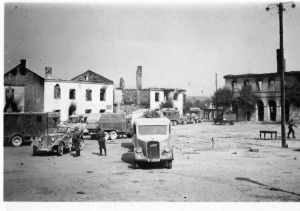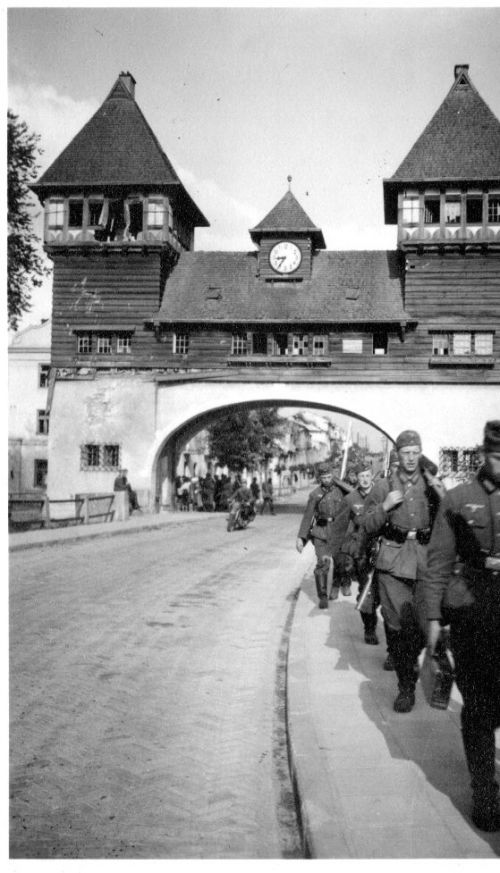Pulawy

Pulawy Main Square - September 1939
Pulawy lies 30 miles by road northwest of Lublin and just prior to the German invasion of Poland on 1 September 1939, approximately 3,600 Jews lived in Pulawy out of an overall population of approximately 12,000. A Wehrmacht unit occupied Pulawy in mid-September 1939 and the Jewish population was immediately confronted with violence and their possessions confiscated, initially carried out by individual German soldiers. Some German soldiers entered Jewish homes at night and took whatever valuables they could find. They brutally beat Jews they found on the streets and took away many for forced labour. Women for example, were ordered to remove their clothes and use them to clean the floors in German offices. Elderly Jewish men were driven from the synagogue in their prayer shawls on Shabbat and compelled to clean toilets with their bare hands. German soldiers also humiliated Jews by cutting of the beards of Jewish men.
Henryk Adler, the chairman of the kehillah and a public school director, was named head of the Jewish Council (Judenrat). Dr Benjamin Honigsfeld, Kleinbaum Edelstein, and Moshe Rubinstein, the pre-war secretary of the kehillah, were among the council members. The German authorities required the Judenrat to raise large ‘contributions.’ By the end of October 1939, the German administration ordered the Jews to move to a specially designated quarter, located in a pre-war district inhabited mostly by impoverished Jews. The ghetto spanned an area which was about one fifth of the total size of Pulawy. Its streets included Piaskowa, Polna, Gdansk, and Niemcewicz and two courtyards. Because air raids and shelling during the first weeks of the war had destroyed many buildings in the ghetto area, Jews were ordered to live only on the undamaged side of Gdansk and Piaskowa Streets. The war damage in Pulawy may have been one of the factors for the early establishment of the ghetto, the first in Lublin District, and indeed among the earliest ghettos created in the General Gouvernement. In early November 1939, the Germans put up posters in Pulawy instructing the Jews to move into the ghetto, one survivor recalled that that the Germans issued an order on 4 November 1939, expropriating all Jewish-owned businesses hours before the Jews had to move into the ghetto. Conditions in the ghetto were poor, there was no sewage system, nor electricity, as the German bombardment had destroyed the power plant in the first few weeks of the war. The area designated for the ghetto was far too small for its 4,000 or so inhabitants. The Germans seized on the opportunity and organised night-time raids on the ghetto to plunder Jewish homes, in search of valuables and jewellery. Brutal beatings were commonplace and if they tried to flee, violating the 5.00 p.m. to 7.00 a.m. curfew they were shot on the spot. The Jewish population was reduced every day, as many young people fled to nearby villages, because they thought the situation would be better, as ghettos had not yet been established. Many also tried to escape to Soviet-occupied territory. Such movement was still possible because the Pulawy ghetto was an ‘open ghetto,’ without a wall or a fence. Jews were also permitted to leave the ghetto for two hours every day.

Pulawy Entrance Gate
The ghetto in Pulawy, was short lived, it was the first ghetto to be liquidated in the Lublin district. Posters were put up by the Germans on 26 December 1939, giving the Jews 48 hours to pack their belongings in preparation for resettlement. Because the temperatures hovered below freezing, the Jewish Council offered the local German authorities a bribe to postpone the evacuation ‘Aktion,’ until the spring. This was rejected as was a similar appeal from a group of Jewish women with young children. The Jews did not enjoy the ‘promised’ 48 hours as the Germans started the ‘Aktion’ on the night of 27 December 1939, German police units, probably from nearby Kazimierz Dolny, stormed the ghetto. They searched Jewish homes with their dogs, ordered men from their beds onto the streets, and ordered women to pack up belongings. This expulsion was accompanied by savage beatings and screaming. The German police units ordered the men to stand in a row on Lublin Street, the main street in Pulawy, facing the buildings with their arms raised, and to sing in the freezing cold till morning. Because they had been dragged from their beds, many were dressed only in nightclothes. The German’s guarding them beat them savagely, whilst SS men standing nearby photographed the beatings. The German police locked the infirm and physically handicapped Jews in the unheated synagogue where they all almost froze to death. The resettlement took place the next morning, at 8.00 a.m. the men held captive along Lublin Street were marched all together to Opole. Along the way some of the German guards brutally beat them. The women were given until noon to vacate Pulawy. Most were forced to walk the 20 miles to Opole with their luggage, as only a few managed to hire wagons. Many infants died from exposure along the road. Some 2,500 Jews arrived in Opole. However, some of the Jews of Pulawy decided to flee to nearby towns and villages, such as Wawolnica, Kazimierz Dolny, and Belzyce.
After German Police units surrounded Kazimierz Dolny early on 29 December 1939, looking to drive out unregistered Jews from the town, most of the refugees from Pulawy were forced to flee from the town across the frozen fields to Belzyce. After the expulsions, the only Jews officially permitted to live in Pulawy were were about 500 Jewish prisoners who were incarcerated in four Judenlager, for forced labourers. The inmates cleaned streets, repaired railway tracks, worked on road construction, and hauled timber at the pre-war state-owned sawmill. In the summer of 1943, SS- Oberscharführer Otto Hantke, who had been in charge of the Jewish forced labour camp in Budzyn until the beginning of December 1942 and afterward in charge of the Jewish forced labour camp in Poniatowa was sent to Pulawy in order to establish the sawmill as a sub-camp of the Lublin concentration camp. Some 486 Jewish were employed in this sub-camp. Although, the sawmill operated at a profit, thanks to the exploitation of the workers, the Jewish prisoners there were liquidated on 3 November 1943, as part of ‘Aktion Erntefest’ (Operation Harvest Festival). The camp operated on a significantly smaller basis until the retreat of the Germans in July 1944, when the Red Army advanced. The sub-camp was finally closed on 22 July 1944.
Sources:
The Yad Vashem Encylopiedia of the Ghettos During the Holocaust Volume 1, Yad Vashem, 2009.
J. Marszalek, Majdanek, Interpress, Warsaw 1986
The Encyclopedia of Camps and Ghettos 1933-1945, USHMM, Indianna University Press Bloomington and Indianapolis 2012
Photographs - Chris Webb Private Archives
© Holocaust Historical Society September 2019

